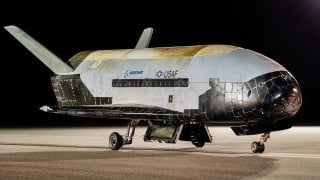China Has Its Very Own Version of the X-37B Space Plane In Orbit
The launch of China's Shenlong on Thursday came hours after the X-37B's seventh mission was scrubbed following weather and technical issues at NASA's Kennedy Space Center in Florida.
Earlier this week, SpaceX was forced to further delay the launch of the U.S. military's X-37B robotic space plane, which had originally been scheduled for last Sunday. That launch was scrubbed due to poor weather conditions at Cape Canaveral.
"We are standing down from tomorrow's Falcon Heavy launch of USSF-52 to perform additional system checkouts. The payload remains healthy while teams work toward the next best launch opportunity. We're also keeping an eye on the weather and will announce a new launch date once confirmed with the Range," SpaceX said in a post on X, the social media platform formerly known as Twitter, on Tuesday.
This would have been the seventh launch of the reusable space plane. During the last mission, the X-37B Orbital Test Vehicle-6 (OTV-6) spent more than 900 days in orbit, surpassing the previous record, held by OTV-5, of 780 days in orbit.
China Launched Its Own Space Plane
If – and really not when – OTV-7 finally makes its way to the heavens and beyond, it will have some company, as China launched its own experimental spacecraft into orbit on Thursday.
This marks the third such launch of Beijing's reusable space plane since 2020. Each has been described as secretive orbital test flights that China has said are aimed at developing reusable technologies to reduce space mission costs.
According to Reuters, which cited Chinese state media reports, the uncrewed spacecraft was launched atop a Long March 2F rocket, the same rocket series used by China to transport its astronauts to space, at the Jiuquan Satellite Launch Center in northwest China on Thursday.
Few details of the mission have been shared, apart from China saying that its space plane will operate in orbit for "a period of time" before returning to a designated landing site. During its flight, reusable technologies will be "verified" while multiple space experiments are conducted.
"After a period of in-orbit operation, the spacecraft will return to the scheduled landing site in China," announced a report from state news agency Xinhua. "It will test reusable technologies during its flight, providing technological support for the peaceful use of space."
The last launch of a Chinese spacecraft began in August 2022, and it returned to Earth after 276 days in orbit. Beijing did not share any details on what technologies may have been tested or even how high the space plane flew.
Images of China's spacecraft – which is unofficially known as the Shenlong ("Divine Dragon" in Chinese") have not been shown to the public. Space.com has reported that the Chinese spacecraft launches vertically atop a rocket, conducts its mission, and then lands horizontally on a runway similar to NASA's space shuttle.
Notable Timing for China and X-37B
The launch of the Shenlong on Thursday came hours after the X-37B's seventh mission was scrubbed following weather and technical issues at NASA's Kennedy Space Center in Florida.
"It's no surprise that the Chinese are extremely interested in our space plane. We're extremely interested in theirs," said Chief of Space Operations Gen. B. Chance Saltzman at this week's Space Force Association's Spacepower Conference, according to Air & Space Forces magazine.
"Because it is a capability; the ability to put something in orbit, do some things, and bring it home and take a look at the results is powerful," Saltzman added. "And so these are two of the most watched objects on orbit while they're on orbit. It's probably no coincidence that they’re trying to match us in timing and sequence of this."
China's Great Leap into Space
Throughout Cold War 1.0, China had lagged behind the U.S. and Soviet efforts. However, it benefited from the cordial Sino-Soviet relations of the 1950s as Moscow had engaged in a cooperative technology transfer program, which essentially kick-started Beijing's space program. As the relationship turned confrontation due to ideological differences, the Soviet assistance to China was abruptly withdrawn.
As a result, China's space efforts were limited until the 1990s – following the dissolution of the Soviet Union – when it once again relied on Russian technology.
Nina Armagno, director of staff of the U.S. Space Force, warned last year that Beijing has made significant progress in developing military space technology, including in areas such as satellite communications and re-useable spacecraft, which could rapidly scale up their space programs.
"I think it’s entirely possible they could catch up and surpass us, absolutely," Armagno said at an event in Sydney run by the Australian Strategic Policy Institute, a research organization partly funded by the U.S. and Australian governments. "The progress they've made has been stunning, stunningly fast."
It would appear that the U.S. is once again in a space race – this time with China. This comes as some policy experts in Washington have continued to signal the alarm that the U.S. Space Force, the sixth and newest branch of the U.S. military, is unequipped to take on emerging space threats from China and Russia.
As of this week, China's space plane is in orbit while the X-37B is sitting on the launch pad.
Author Experience and Expertise
Peter Suciu is a Michigan-based writer. He has contributed to more than four dozen magazines, newspapers, and websites with over 3,200 published pieces over a twenty-year career in journalism. He regularly writes about military hardware, firearms history, cybersecurity, politics, and international affairs. Peter is also a Contributing Writer for Forbes and Clearance Jobs. You can follow him on Twitter: @PeterSuciu.
All images are Creative Commons.


